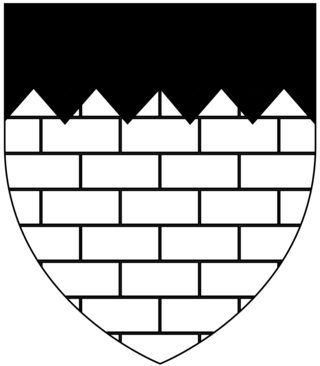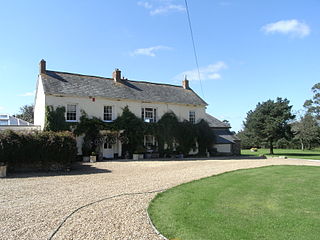
Walter Reynell (died 1475), of Malston in the parish of Sherford, was an English landowner, administrator and politician from Devon who sat as MP for Totnes in 1447 and as MP for Devon in 1453. [1] [2] [3]

Walter Reynell (died 1475), of Malston in the parish of Sherford, was an English landowner, administrator and politician from Devon who sat as MP for Totnes in 1447 and as MP for Devon in 1453. [1] [2] [3]
Born about 1395, he was the son of Walter Reynell (died after 1424), a landowner who sat as MP for Devon in 1404, and his second wife Margaret Stighull (died before 1399), daughter of William Stighull and his wife Elizabeth Malston. His paternal grandparents were John Reynell (died before 1365), reported to have been MP for Cambridgeshire in 1351, and his wife Maud Fulbourn, daughter of Giles Fulbourn. The MP John Reynell was his younger half-brother. [1] [2] [3]
In 1415, at a young age, he was serving in the army of King Henry V in Normandy. [3]
Back in England, after the death of his father he was sworn as a justice of the peace for Devon in 1434 and in 1435 was involved in an acrimonious lawsuit over inherited land in Cambridgeshire. From 1442 onwards his name appears on royal commissions for Devon and as a witness to a court case in the port of Dartmouth. After he had sat as MP for Totnes in 1447, a royal commission was appointed in July 1450 to enquire into the names of the malefactors who, together with Robert Wennington of Dartmouth, an MP and privateer, had assaulted and illegally imprisoned Walter Reynell “so that his life was despaired of” until he provided Wennington a written release from all law suits. In 1453 he was again returned to Parliament as MP for Devon and in 1455 was on the electoral roll in both Devon and Exeter. [1]
He died on 25 February 1475. As his eldest son had died before him, his heir was his eldest grandson John Reynell, aged 15, who died childless. [1]

About 1425 he married Joan Walrond, daughter of William Walrond, of Bradfield in the parish of Uffculme, and his wife Juliana. [2] and their children included:
Bowden is a historic estate in the parish of Yealmpton in Devon, England. From the 15th century until 1748 the manor house was for eight generations the seat of a junior branch of the Copleston family of Copplestone. The manor house was largely rebuilt in the 19th century and, together with some of its outbuildings, now serves as a farmhouse.

Sir Coplestone Bampfylde, 2nd Bt., DL, JP of Poltimore and North Molton and Warleigh, Tamerton Foliot, in Devon, was an English politician who sat in the House of Commons at various times between 1659 and 1689.
John Rashleigh II of Menabilly, near Fowey in Cornwall, was an English merchant and was MP for Fowey in 1588 and 1597, and was High Sheriff of Cornwall in 1608. He was the builder of the first mansion house on the family estate at Menabilly, near Fowey, Cornwall, thenceforth the seat of the family until the present day. Many generations later the Rashleigh family of Menabilly in the Return of Owners of Land, 1873 was listed as the largest landowner in Cornwall with an estate of 30,156 acres (122.04 km2) or 3.97% of the total area of Cornwall.
Sir Richard Reynell, of Pitney in the county of Somerset, Sheriff of Devon in 1191-4, was a knight who lived during the successive reigns of Kings Henry II (1154-1189), Richard I (1189-1199) and John (1199-1216).

Kentisbeare is a village and civil parish in the Mid Devon district of Devon, England. Its nearest town is Cullompton.

Thomas Reynell of East Ogwell, Devon, was an English lawyer and politician who sat in the House of Commons at various times between 1654 and 1689.

Sir Edward Giles (1566–1637) of Bowden House, Ashprington, near Totnes, Devon, was an English politician who sat in the House of Commons at various times between 1597 and 1629.

Sir Carew Reynell was an English courtier, soldier and politician who sat in the House of Commons at various times between 1593 and 1622.

Sir John Davie, 2nd Baronet (1612–1678) of Creedy in the parish of Sandford, Devon, was Member of Parliament for Tavistock, Devon, in 1661 and was Sheriff of Devon from 1670 to 1671.

Bradfield House is a Grade I listed country house situated in the parish of Uffculme, Devon, England, 2 miles (3.2 km) south-west of the village of Uffculme.

The historic manor of Raleigh, near Barnstaple and in the parish of Pilton, North Devon, England, was the first recorded home in the 14th century of the influential Chichester family of Devon. It was recorded in the Doomsday Book of 1086 together with three other manors that lay within the later-created parish of Pilton. The manor lies above the River Yeo on the southern slope of the hill on top of which stand the ruins of the Anglo-Saxon hillfort called Roborough Castle. Part of the historic manor of Raleigh is now the site of the North Devon District Hospital.

Way is a historic estate in the parish of St Giles in the Wood, Devon. It is situated about 2 miles (3.2 km) north-east of the village of St Giles in the Wood and about 4 miles (6.4 km) north-east of the town of Great Torrington. It was described by Hoskins (1959) as "the fons et origo of the mighty tribe of Pollard" and had been acquired by them from the de la Way family at some time before 1242.

John Peryam, of Exeter, Devon, was elected four times as a Member of Parliament, for Barnstaple 1584, Bossiney 1586, Exeter 1589 and 1593. He served as Mayor of Exeter. He was the younger brother of Sir William Peryam (1534-1604) of Little Fulford, near Crediton in Devon, Lord Chief Baron of the Exchequer.

Creedy is an historic estate in the parish of Sandford, near Crediton in Devon. It is named from its location on the west side of the River Creedy. It was the seat of the Davie family from about 1600 until the late 20th century. The mansion house on the estate has been called at various times New House, Creedy House, and as presently, Creedy Park. It was first built in about 1600, rebuilt in 1846, burnt down in 1915 and rebuilt 1916–21. It is surrounded by a large park, the boundary of which is enclosed by a stone and brick wall several miles long.

Warleigh is an historic estate within the parish of Bickleigh in Devon, about 6 miles from Plymouth. Warleigh House, the manor house of the manor of Tamerton Foliot is situated one mile west of that village on the south-east bank of the River Tavy where it joins the River Tamar. It was remodelled in about 1830 in the Gothic style by John Foulston and has been listed Grade II* on the National Heritage List for England since 1960.

Thomas Peyton (1418–1484) of Isleham, Cambridgeshire, was twice Sheriff of Cambridgeshire and Huntingdonshire, in 1443 and 1453. He rebuilt the church of St Andrew's in Isleham, in the chancel of which survives his monumental brass. He is depicted in a 1485 stained glass window in Long Melford Church, Suffolk, where he displays on his surcoat the Peyton arms: Sable, a cross engrailed or a mullet in the first quarter argent.

William Fowell of Fowelscombe in the parish of Ugborough in Devon, was a Member of Parliament for Totnes in Devon in 1455.

Walter Reynell was an English landowner, soldier, administrator and politician who sat as Member of Parliament for Devon in 1404.

John Reynell was a Member of Parliament for Devon in 1427/28.
Thomas Coplestone (1688–1748) of Bowden, Yealmpton, Devon, was a British landowner and Whig politician who sat in the House of Commons for 29 years from 1719 to 1748.
{{cite book}}: CS1 maint: location missing publisher (link)